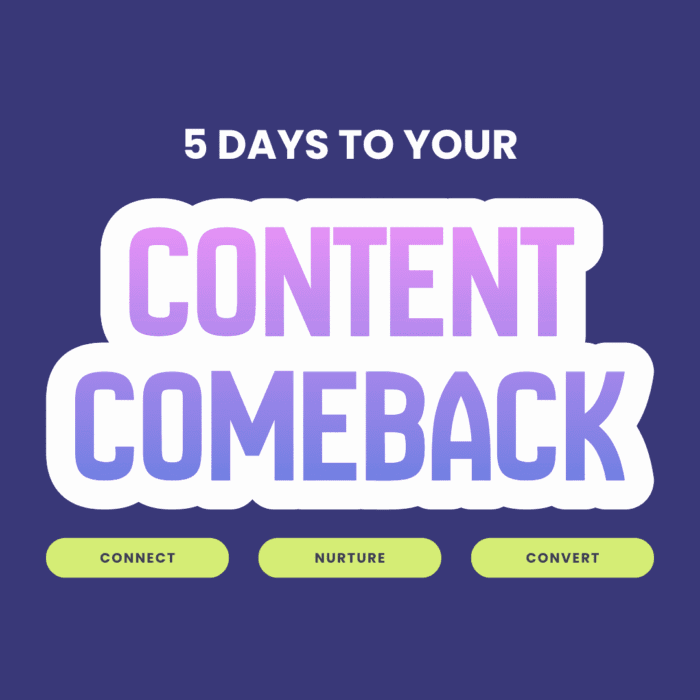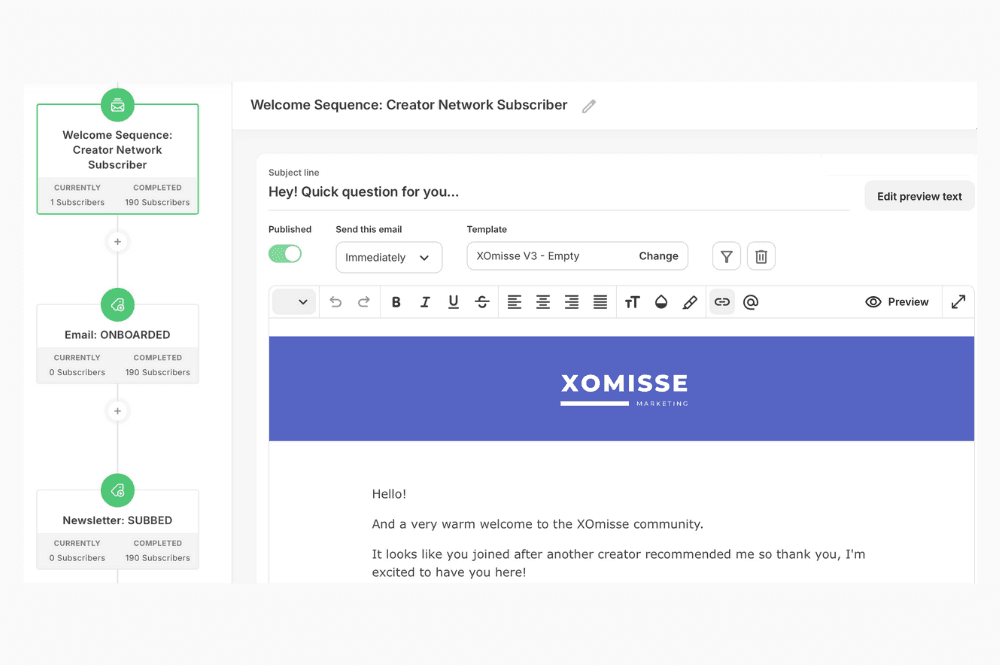If you’ve taken the brave step of starting an email list, you’ve already done the hardest part. Truly. Most business owners get stuck at the starting line, so you’re already ahead.
But once the signups start coming in, the next question usually appears: “I have subscribers… now what?”
If you’re already juggling client work, creating content, replying to DMs and trying to find an extra hour in the day, the idea of setting up anything might feel overwhelming.
The good news is that the very next step is simple, strategic and doesn’t require any tech wizardry. It’s a small piece of upfront work that continues paying off for years.
It’s your welcome series.
A welcome series is a short sequence of emails automatically sent to every new subscriber. It bridges the gap between someone joining your list and them becoming an engaged reader or customer.
If you’ve ever heard terms like “autoresponder” or “automation”, this is exactly that. Your email platform sends these emails for you at the times you choose. And once it’s set up, it quietly works in the background while you focus on everything else.

Why a welcome series matters more than you think
Before we get into the structure, it helps to understand why a welcome series is so powerful for small business owners and creators.
- Engagement is highest at the start: People are most excited about your brand right after signing up. They’re paying attention. This is your chance to make a strong first impression.
- It sets the tone: Your welcome series introduces your personality, style and expertise. It helps subscribers understand what you talk about, how often you email and the value they can expect.
- It saves time: You write it once and it serves every new subscriber. This is true hands-off marketing.
- It improves deliverability: If people open and click your early emails, your email service provider recognises you as a reliable sender, improving your chances of landing in the inbox.
A welcome series is small but mighty. It’s the easiest way to turn new subscribers into warm leads before you’ve even lifted a finger.
Your Content Comeback
Fallen off your content routine? Join this 5-day challenge to create content that connects, nurtures and converts.

A simple 3-email welcome series you can create today
You don’t need a long, complicated sequence. Three thoughtful emails are enough to build trust, show your expertise and guide subscribers towards the next step.
Email 1: The thank you and hello
Sent immediately, this first email is your warm hello.
It welcomes your new subscriber, gives them whatever you promised and gently sets expectations for what comes next.
The aim here is to build trust, offer value right away and help them feel confident they’re in the right place.
What to include in the first email
1. Gratitude and freebie (if relevant)
Thank them for joining and provide a clear link to your download or resource.
Example: “Here is your ‘7 Days to Better Branding’ PDF. Click here to download it.”
2. A friendly introduction
Who are you, who do you help and why do you do what you do?
Example: “I’m Jess, and I help service providers move from brand confusion to a consistent, magnetic brand identity.”
3. Set expectations
Tell them what type of emails you send and how often.
Example: “You’ll hear from me every Tuesday with simple branding tips and honest lessons from my business journey.“
4. Ask an easy question
A short question encourages replies, which strengthens deliverability.
Example: “Reply and tell me: What’s the biggest struggle you have with your brand right now?”

Email 2: The value builder
Sent 1–2 days later.
By now your subscriber knows who you are, so this email is all about showing what you can help them achieve.
It’s your chance to offer a quick win, share something genuinely helpful and quietly demonstrate your expertise. The goal is simply to deepen the relationship, not sell.
When you’re deciding what to share in this second email, keep it simple and focus on solving one small but meaningful problem your subscriber is likely facing.
For example, if you’re a virtual assistant, you might help someone who feels unsure about what tasks to delegate by sharing a quick 3-step guide such as “The 10-Minute Brain Dump” to help them identify their first delegation tasks. A home baker or creator could support readers who feel their bakes look amateurish by linking to a short video demonstrating how to get perfectly smooth icing every time. And a financial coach might speak to the common guilt around spending money on a business, offering a short, reassuring resource about why investing in your business is an asset rather than an expense.
Choose one problem and guide your reader to one helpful resource. If you can add a short personal story or behind-the-scenes moment, even better. It deepens the connection.
Email 3: The next step and call to action
Sent 3–4 days later.
At this stage, your subscriber has seen your value and understands your approach, so this email gently guides them towards the next natural step. It connects the dots between the free advice you’ve shared and the deeper support you offer.
| Your offering | The bridge | CTA |
|---|---|---|
| Online course | “If that small tip helped, imagine what you can achieve with a full step-by-step roadmap” | “Join the Create Your Course waitlist” |
| 1:1 service | “While I love sharing free advice, the fastest results come from personalised support” | “Check my availability and book a free discovery call” |
| Template shop | “If you want to simplify your workflow, I’ve created templates that take care of the heavy lifting” | “Browse the best-selling template collection” |
The aim is to show them how they can go further with you, without pressure. Keep this email focused, one offer and one clear action.
Final thoughts
Setting up a welcome series might take you an afternoon, but it will continue nurturing subscribers and showcasing your expertise long after it’s written.
You don’t need advanced tech skills to do this. Open your email platform, find the automation or workflow section and build your three emails using the structure above.
A well-crafted welcome series makes your business feel organised, professional and intentional. It helps new subscribers feel supported from the moment they join your list and gives you a consistent way to turn newcomers into warm leads and, eventually, loyal customers.
Start small, write in your own voice and trust that this simple system will work hard behind the scenes while you focus on the rest of your business.
